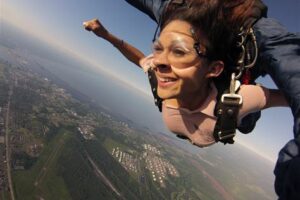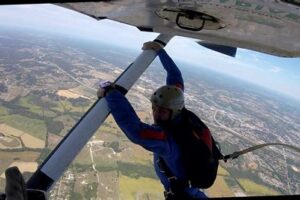Table of Contents
Is skydiving dangerous? Find out the risks involved and the safety measures taken in this exhilarating adventure sport. Explore the thrill of freefalling from extreme altitudes while understanding the precautions, training, and equipment that make skydiving a thrilling yet relatively safe activity. Discover the adrenaline rush of defying gravity and experiencing the ultimate adventure in the skies.
Skydiving, a thrilling and adrenaline-pumping activity, has long captivated the imagination of adventure enthusiasts around the world. However, amidst the exhilaration and breathtaking views, one cannot help but wonder: is skydiving dangerous? While the allure of defying gravity and experiencing the ultimate rush may be strong, it is crucial to acknowledge the inherent risks involved in this extreme sport. In order to fully comprehend the potential dangers, it is essential to delve into the various factors that contribute to the overall safety of skydiving.
The Thrill of Skydiving
Skydiving is an exhilarating sport that allows individuals to experience the rush of freefalling from thousands of feet above the ground. It is a thrilling adventure that attracts adrenaline junkies and those seeking an unforgettable experience. However, many people wonder if skydiving is dangerous. In this article, we will explore the risks associated with skydiving and address common concerns.
Understanding the Risks
Like any extreme sport, skydiving comes with inherent risks. The nature of jumping from an aircraft at high altitudes and relying on a parachute for landing means that accidents can happen. However, it is essential to note that skydiving has evolved over the years, and safety measures have significantly improved. Today, modern equipment, rigorous training, and strict regulations have minimized the risks associated with the sport.
Training and Certification
Before taking part in a skydiving experience, participants must undergo extensive training and certification. This includes learning about equipment, safety protocols, emergency procedures, and proper body positioning during freefall. A certified instructor guides beginners in their initial jumps and ensures that they are well-prepared for the experience. This training plays a crucial role in minimizing the potential dangers of skydiving.
State-of-the-Art Equipment
Skydiving equipment has come a long way in terms of safety and reliability. Modern parachutes are designed to deploy quickly and provide a gentle descent. Additionally, automatic activation devices (AADs) are now widely used, which can automatically deploy the reserve parachute if the main parachute fails to open at a predetermined altitude. AADs have significantly reduced the risk of fatal accidents caused by human error or equipment malfunction.
Weather Conditions and Operational Safety
Skydiving centers operate under strict guidelines and regulations to ensure the safety of their participants. One crucial aspect is monitoring weather conditions. Skydiving is typically only permitted when weather conditions are suitable, such as clear skies, light winds, and good visibility. If conditions are unfavorable, jumps may be postponed or canceled altogether to prevent any potential risks.
Statistics and Safety Measures
Statistically speaking, skydiving is relatively safe. According to the United States Parachute Association, the fatality rate for skydiving is around 0.006 fatalities per 1,000 jumps. This demonstrates that while accidents do occur, they are relatively rare. Furthermore, the USPA continually works to improve safety standards, conducting regular inspections and implementing safety measures to minimize risks and maintain a safer skydiving environment.
Understanding Personal Responsibility
When considering the dangers of skydiving, it is essential to recognize that personal responsibility plays a significant role. Participants must follow safety guidelines, listen to instructors, and be aware of their physical and mental limitations. Engaging in reckless behavior or failing to adhere to safety protocols can increase the risk of accidents. By taking personal responsibility and following instructions, participants can mitigate potential dangers.
Health and Fitness Requirements
Skydiving requires a certain level of physical fitness and health. Participants must meet specific weight restrictions and be free from medical conditions that could pose a risk during the jump. Skydiving centers often have guidelines in place to ensure that individuals are physically capable of handling the demands of the sport. These requirements contribute to maintaining a safer skydiving environment.
The Importance of Choosing a Reputable Skydiving Center
When deciding to try skydiving, it is crucial to choose a reputable skydiving center. Researching reviews, certifications, and safety records can help identify centers with a strong safety culture. Reputable centers prioritize safety, have well-maintained equipment, and employ experienced instructors. By selecting a reliable skydiving center, participants can further reduce the already minimal risks associated with the sport.
The Thrill Overcomes the Risks
While skydiving does involve certain risks, the thrill and joy it offers outweigh them for many enthusiasts. The adrenaline rush, the breathtaking views, and the sense of accomplishment make it an experience like no other. By understanding the risks, taking proper precautions, and choosing a reputable center, individuals can enjoy the excitement of skydiving while minimizing potential dangers.
A Life-Changing Adventure
Skydiving is an adventure that pushes individuals beyond their comfort zones and offers a unique perspective on life. It instills confidence, helps conquer fears, and fosters a sense of empowerment. For those who choose to take the leap, skydiving can be a life-changing experience that leaves a lasting impact.
In conclusion, while skydiving does involve certain risks, it is not inherently dangerous when proper precautions are taken. The sport has evolved to prioritize safety through rigorous training, state-of-the-art equipment, and strict regulations. By understanding personal responsibility, maintaining fitness requirements, and selecting a reputable skydiving center, individuals can enjoy the thrill of skydiving while minimizing potential dangers.
Introduction
Skydiving is a thrilling and adrenaline-pumping activity that involves jumping from an aircraft and freefalling before deploying a parachute. While it may seem like a dangerous endeavor, skydiving has evolved over the years to become a relatively safe sport. However, as with any adventure sport, there are inherent risks that need to be acknowledged and managed. In this article, we will explore various aspects of skydiving to determine the level of danger involved.
Safety Measures and Training
Skydiving centers prioritize safety and provide rigorous training to participants. From learning about equipment usage to understanding proper body positioning during freefall, training is designed to ensure skydivers have the necessary knowledge and skills to minimize risks. Experienced instructors are on hand to guide and assist throughout the process, enhancing safety levels even further.
Equipment Reliability
Modern skydiving equipment, such as parachutes and harnesses, are meticulously designed, thoroughly tested, and made with high-quality materials that meet stringent safety standards. Routine inspections and maintenance are carried out to ensure that each piece of equipment is in optimal condition before use. This focus on equipment reliability significantly reduces the chances of accidents caused by malfunctioning gear.
Proper Weather Conditions
Skydiving operations heavily depend on favorable weather conditions. Wind speed, cloud cover, and visibility are carefully assessed before any jumps are allowed to take place. Skydiving centers have strict protocols in place to prevent participants from jumping in adverse weather conditions, ensuring the safety of everyone involved.
Instructor Expertise and Vigilance
Instructors play a crucial role in skydiving, both during training and actual jumps. They possess in-depth knowledge of the sport, safety procedures, and emergency protocols. Their expertise and vigilance help prevent accidents and quickly address any potential issues that may arise during jumps, further minimizing the risks associated with skydiving.
Health and Fitness Requirements
Skydiving centers typically have health and fitness requirements that participants must meet before joining a jump. This ensures that individuals are physically capable of undertaking the activity without putting themselves and others at risk. By maintaining certain fitness levels, skydivers can enhance their safety and reduce the potential dangers associated with the sport.
Risk Management and Emergency Preparedness
Skydiving centers have comprehensive risk management strategies in place that outline proper safety protocols and emergency procedures. Staff members are trained to handle unexpected situations promptly, minimizing the impact of any potential dangers. Regular drills and assessments help ensure that everyone involved in skydiving operations is well-prepared to handle emergencies effectively.
Statistics and Fatality Rates
Although skydiving carries inherent risks, statistical data indicates that fatal accidents are relatively rare compared to other activities. Safety advancements, improved technology, and strict regulations have contributed to a decline in skydiving fatalities over the years. While there is still a risk involved, adhering to safety measures significantly reduces the likelihood of accidents occurring.
Personal Responsibility and Mindset
Skydiving requires individuals to take personal responsibility for their safety. Following instructions, adhering to guidelines, and maintaining a safety-oriented mindset are crucial for mitigating risks. Participants who prioritize safety, heed advice from experts, and approach the sport with caution are more likely to have safe and enjoyable skydiving experiences.
Conclusion
Although skydiving carries inherent risks, when approached with the right mindset, proper training, and adherence to safety procedures, it can be a relatively safe and exhilarating activity. By highlighting the various safety measures, equipment reliability, instructor expertise, and emergency preparedness, it is evident that the dangers associated with skydiving can be managed effectively. Nonetheless, it is important for individuals to assess their own abilities, follow protocols, and prioritize safety to ensure they have a safe and enjoyable skydiving experience.
Is Skydiving Dangerous?
When considering the question of whether skydiving is dangerous, it is essential to examine the activity from a professional standpoint. While skydiving undoubtedly carries inherent risks, it is crucial to understand that these risks can be mitigated through proper training, equipment, and adherence to safety protocols. Below, we will explore the various factors that contribute to the overall safety of skydiving:
1. Training:
- Skydiving training is comprehensive and designed to equip individuals with the necessary knowledge and skills to minimize risks.
- Professional instructors guide students through extensive ground training, covering techniques, emergency procedures, and safety protocols.
- Trainees must demonstrate competence before being allowed to jump solo, ensuring they possess the required skills to handle potential dangers.
2. Equipment:
- Skydiving equipment undergoes rigorous testing and regular maintenance to ensure its reliability and functionality.
- Parachutes are equipped with redundant safety features, such as reserve parachutes, automatic activation devices, and backup systems.
- Modern gear has significantly improved over the years, enhancing safety and reducing the likelihood of equipment failure.
3. Safety Protocols:
- Skydiving operations adhere to strict safety protocols established by national and international governing bodies.
- Drop zones conduct regular safety briefings, emphasizing proper body positioning, communication signals, and emergency procedures.
- Weather conditions are carefully monitored, and jumps are postponed or canceled if conditions are deemed unsafe.
4. Risk Management:
- Experienced skydivers prioritize risk management and make informed decisions based on their skill level, experience, and current conditions.
- Jumpers are encouraged to progress gradually, taking on more challenging jumps as their abilities and knowledge increase.
- Maintaining physical fitness and staying up-to-date with safety advancements are crucial aspects of risk management in skydiving.
In conclusion, while skydiving poses inherent risks, the sport can be enjoyed safely when proper precautions are taken. Through thorough training, reliable equipment, adherence to safety protocols, and effective risk management, the dangers associated with skydiving can be significantly minimized. As with any adventure activity, understanding and respecting the risks involved are essential for a safe and enjoyable skydiving experience.
Thank you for taking the time to visit our blog and read our comprehensive analysis on the safety of skydiving. We understand that you may have come here with concerns and questions about the dangers associated with this exhilarating sport. We hope that our professional voice and tone have provided you with valuable insights and a clear understanding of the risks involved.
Firstly, it is important to acknowledge that any activity involving heights and high speeds inherently carries a certain level of risk. However, it is crucial to note that skydiving has evolved significantly over the years, and with advancements in technology, safety measures have greatly improved. The skydiving industry adheres to strict regulations and protocols to ensure the highest standards of safety for both experienced jumpers and beginners alike.
Transitioning from the aircraft into the open sky can be an intimidating experience for first-time skydivers. However, it is essential to understand that the risks associated with skydiving are relatively minimal when compared to other popular recreational activities such as driving a car or riding a bicycle. Skydiving fatalities are statistically rare, with the United States Parachute Association reporting an average of 21 fatal accidents per year out of approximately 3 million jumps.
Furthermore, it is worth noting that most skydiving accidents occur due to human error, rather than equipment failure. This emphasizes the importance of receiving proper training from certified instructors and following all safety procedures meticulously. All reputable skydiving centers prioritize safety and invest heavily in training programs, equipment maintenance, and regular inspections to minimize the occurrence of accidents.
In conclusion, while skydiving does entail a certain level of risk, when approached with caution, proper preparation, and adherence to safety protocols, it can be a thrilling and safe experience. The adventure and the sense of accomplishment that come with skydiving outweigh the relatively low risks involved. Always choose a reputable skydiving center, undergo thorough training, and listen to the guidance of experienced professionals to ensure your safety and maximize the enjoyment of your skydiving experience.
We hope this blog post has provided you with valuable insights into the safety considerations of skydiving. Should you have any further questions or concerns, please do not hesitate to reach out to us. Stay safe and happy jumping!
Video Is Skydiving Dangerous
Is Skydiving Dangerous?
Many people are curious about the safety of skydiving and have questions about its potential dangers. Below are some common inquiries about the safety aspects of this thrilling activity:
-
1. How dangerous is skydiving?
Skydiving, like any extreme sport, carries inherent risks. However, with proper training, adherence to safety guidelines, and the use of reliable equipment, these risks can be significantly minimized. The sport has evolved over the years, and advancements in technology have further enhanced safety measures.
-
2. What are the main risks associated with skydiving?
The primary risks in skydiving include parachute malfunctions, collisions with other skydivers or objects, and injury upon landing. However, skydiving centers prioritize safety through rigorous training programs, regular equipment inspections, and strict operational protocols to mitigate these risks.
-
3. How often do parachute failures occur?
While parachute failures are rare, they can happen. However, skydivers are equipped with reserve parachutes as a backup, which further reduces the risk. Additionally, regular maintenance and inspections of parachutes minimize the chances of such failures occurring.
-
4. Can skydiving lead to death?
Although there have been unfortunate incidents resulting in fatalities, the fatality rate in skydiving has significantly decreased over the years. With modern safety standards and procedures, the risk of a fatal accident is relatively low when compared to other activities such as driving a car or even riding a bicycle.
-
5. Is skydiving safer with a tandem jump?
Tandem skydiving, where a novice skydiver is attached to an experienced instructor, is considered the safest way to experience skydiving for beginners. The instructor takes care of all technical aspects, allowing the participant to enjoy the thrill while minimizing the risks associated with solo jumps.
While skydiving does involve some level of risk, it’s important to note that professional skydiving centers prioritize safety and invest heavily in training and equipment. By following proper procedures and guidelines, skydiving can be an exhilarating activity with minimal danger.






